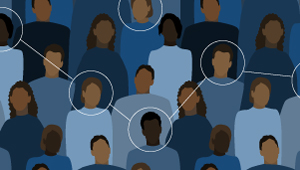Detecting, assessing suicidal ideation during COVID-19

Drs. Greg Simon and Megan Gary share how new processes improved suicide risk identification when mental health visits went virtual
By Gregory Simon, MD, MPH, senior investigator, Kaiser Permanente Washington Health Research Institute, and psychiatrist, Washington Permanente Medical Group; and Megan Gary, MD, MHA, adult psychiatrist and assistant medical director of Mental Health and Wellness, Kaiser Permanente Washington
In March 2020, outpatient mental health care across the United States shifted from in-person visits to virtual visits. Over the course of the following year, new processes — from screening methods to alerting clinic staff — were developed for virtual visits to help identify those at risk for suicide and provide them with timely clinical care. With virtual visits continuing at a much higher level than prior to the pandemic, the new processes continue to be invaluable.
At Kaiser Permanente Washington (KPWA), video visits had been available for years, but telephone and video visits accounted for only 7% of visits to Mental Health and Wellness (MHW) clinics during the week starting March 9, 2020. That proportion increased to 64% the following week and 98% the week after.
By April 2020, MHW leaders’ attention shifted from technology and logistics of virtual care back to quality and safety — especially regarding the identification of people at risk for suicidal behavior.
Prior to the pandemic, KPWA had implemented standard work to:
- Identify people at risk
- Systematically assess risk
- Develop collaborative safety plans with members at highest risk
These standard care processes were designed for traditional in-person visits — relying on completion of paper-and-pencil screening questionnaires in waiting areas or clinician offices. However, by late March 2020, waiting areas were largely empty and clinician offices had become video studios.
While clinicians could still read out screening questionnaires during video and telephone visits or manually send questionnaires prior to the visit via the electronic health record (EHR) patient portal, the proportion of visits with a completed screening questionnaire dropped from 80% at the beginning of March to 45% at the end of the month. Similarly, the proportion of screening questionnaires “positive” for suicidal ideation that were followed by a structured risk assessment fell from over 95% to approximately 75% — demonstrating that while suicidal ideation wasn’t necessarily decreasing, risk assessments may have been falling through the cracks.
During the remainder of 2020, MHW clinics implemented a series of new processes, detailed in the July 2021 issue of The Joint Commission Journal on Quality and Patient Safety, to improve identification of suicide risk during virtual visits:
- April 2020: Monitoring questionnaires were sent via the EHR patient portal prior to all scheduled video visits, but not prior to telephone visits. The proportion of all MHW visits with a completed monitoring questionnaire gradually increased to approximately 55%, and the proportion of “positive” screening questionnaires followed by a risk assessment increased to approximately 85%.
- October 2020: Screening questionnaires were sent via the EHR patient portal prior to telephone visits as well as video visits.
- November 2020: Members who reported frequent suicidal ideation on screening questionnaires were automatically and immediately directed to a more detailed risk assessment questionnaire.
- End of 2020: The proportion of MHW visits with a completed screening questionnaire had increased to over 60%, and the proportion of “positive” screening questionnaires followed by a structured risk assessment approached 100%.
Monitoring suicide risk after business hours
Identifying suicide risk via patient portal questionnaires raised some concerns regarding the availability of an immediate response — especially for questionnaires completed after hours or on weekends. Discussions among MHW leadership, health plan leadership, and medical group leadership helped clarify some key points, including that asking questions regarding suicide risk did not create risk. Instead, online questionnaires revealed already-existing risk that the health system had already committed to identify and address. Concerns regarding online suicide risk questionnaires were motivated primarily by fear of liability rather than a commitment to quality and safety.
Following these discussions, MHW leaders chose to proceed with an online assessment of suicide risk while implementing appropriate procedures to assure timely outreach. If responses to the risk assessment questionnaire indicated recent suicidal planning or intent, immediate alerts were routed to MHW clinic staff (for questionnaires completed during clinic hours) or to the KPWA consulting nurse service (for questionnaires completed outside of clinic hours).
While we anticipate that in-person mental health visits will increase as COVID-19 continues to subside, we also expect that virtual visits will continue at a much higher level than prior to the pandemic. We hope that our new processes to address virtual visits will continue to help identify those at risk for suicide and provide them with timely clinical care.
Gregory Simon, MD, MPH, is a senior investigator at Kaiser Permanente Washington Health Research Institute and a psychiatrist at Washington Permanente Medical Group in Seattle. Dr. Simon conducts extensive research on practice approaches to improving mental health care. His current areas of focus include identifying and assessing suicide risk, improving care for treatment-resistant depression, and the early intervention for mental health conditions in children and youth.
Megan Gary, MD, MHA, is an adult psychiatrist at Kaiser Permanente Washington who also holds a dual role as assistant medical director of Mental Health and Wellness. Dr. Gary is also board-certified in addiction psychiatry.
A version of this blog originally appeared on the Joint Commission website.
Healthy Findings Blog

Delivering on the real promise of virtual mental health care
Dr. Gregory Simon tells how telehealth, prompted by COVID-19, shifts care from passive response to active outreach.
News

Examining racial inequity in suicide prediction models
Kaiser Permanente researchers stress need to test how prediction models perform in all racial, ethnic groups.
recognition

Dr. Greg Simon wins national suicide prevention award
Kaiser Permanente physician-scientist will receive American Foundation for Suicide Prevention's Lifesavers Research Award.


